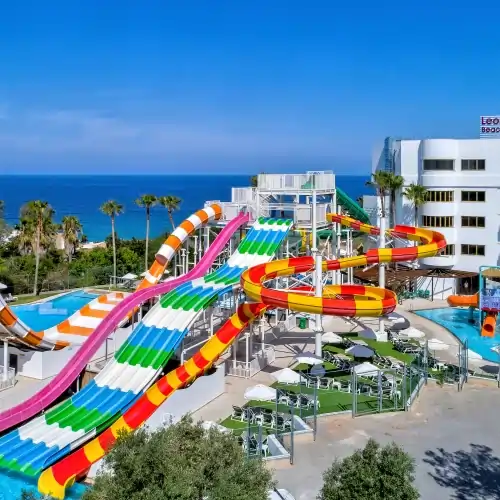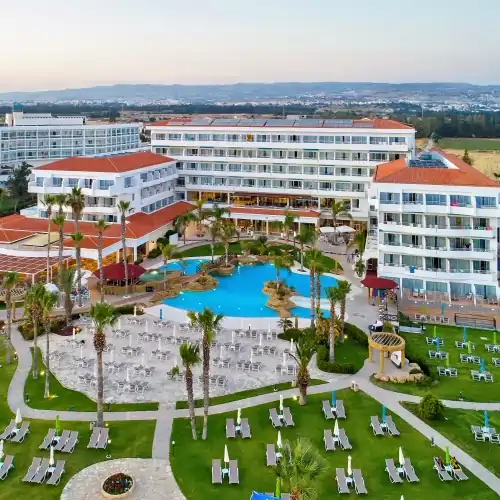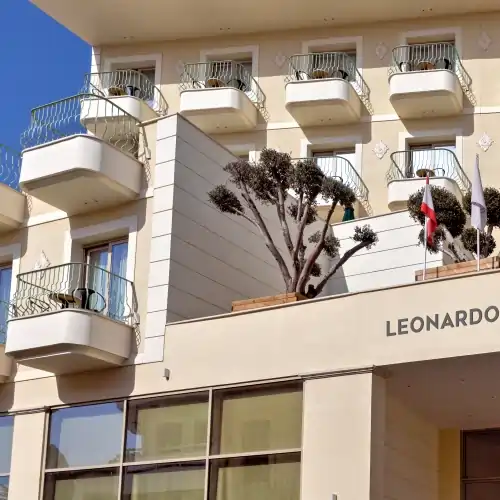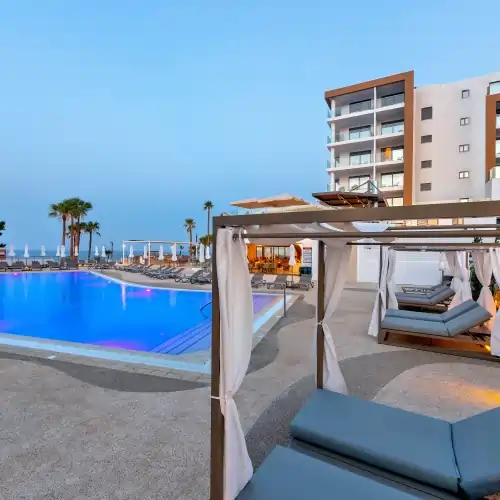- Book Now
- Home Page
- Destinations
- City Guides
- City Guides
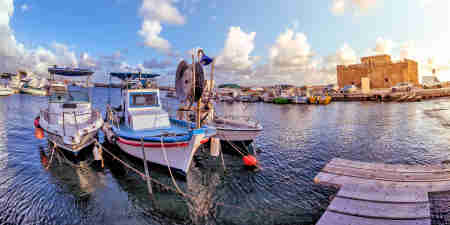 Explore Paphos
Explore Paphos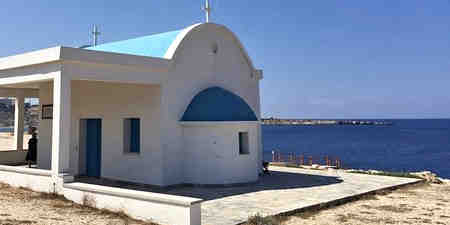 Explore Protaras
Explore Protaras
- Special Offers
- Weddings
- Meetings & Events
- About Us
- Contact Us
- Get A Quote
- Manage your Bookings
- English
On an island where the majority of the population is Greek Orthodox, the church of Agia Kyriaki Chrysopolitissa is a dream come true for many Catholic couples who want to tie the knot in paradise. It’s a beautiful church, which traces its roots back to the largest basilica of Cyprus in the 4th century AD.
Agia Kyriaki Chrysopolitissa: The Church at St. Paul’s Pillar
Agia Kyriaki Chrysopolitissa – also Agia Kyriaki (St. Kyriaki), Panagia Chrysopolitissa (Our Lady of the Golden City), the Church at St. Paul’s Pillar, and St. Paul’s Catholic Church – is a religious landmark in the Kato Pafos area inscribed in the list of the UNESCO World Heritage Sites in 1980.
It’s a beautiful church – in tan, umber, and ochre earth tones when seen from afar – set amidst the ruins of a former Bizantine basilica, a Gothic place of worship, and the columns once used to punish the unruly. One of these posts, just outside the walls of Agia Kyriaki Chrysopolitissa, is the legendary St. Paul’s Pillar, said to be the very spot where Roman Governor Sergius Paulus punished the Apostle for preaching Christianity on Cyprus.
The patchy history of the church is not unusual considering that Cyprus was at the crossroads of many cultures and peoples. Reigned by Assyrians, Persians, and Egyptians in ancient times, even taken over by Alexander the Great, then falling under the rule of the Roman and Byzantine empires, raided by Arabs, and a favorite stop in the way of the Crusaders, Cyprus eventually lost a lot of her temples during the Ottoman occupation. It’s a wonder that the church of Agia Kyriaki Chrysopolitissa was spared at that time. The Gothic church built in the 13th century near this sacred destination was destroyed. Its ruins, hard to distinguish from the remains of the first basilica, make a pretty setting for walks and wedding photography.
The consecrated building standing today on some of the foundations of the former basilica was erected around 1500 AD during the Venetian rule on the site of an earlier church destroyed by the earthquake of 1159.
The church of Agia Kyriaki Chrysopolitissa is a favorite wedding venue for Anglican and Catholic couples. Ceremonies are regularly offered here. The structure can accommodate up to 200 guests.
Read More
Read Less




Located next to the village of Panayia, Panagia Chrysorogiatissa Monastery is one of the religious heritage sites of Paphos. It was founded in 1152 AD, during the rule of Manuel I Komnenos of Byzantium, by a monk called Ignatius who entered in possession of an icon of the Virgin Mary allegedly painted by St. Luke the Evangelist.
Panagia Chrysorogiatissa Monastery Boasts Its Own Winery
The Panagia Chrysorogiatissa Monastery, also spelled Chrysoroyiatissa or Chrysorroyiatissa, is a sacred temple dedicated to Our Lady of the Golden Pomegranate. Its history is intricate and wondrous. Little is known about the monastery until the visit of Russian monk Vassilios Barsky, who, upon his arrival here in 1735 found a modest church with two or three cells and monks maintaining the place through agricultural work and goat keeping. But he was impressed by the location of the monastery, in a fertile land with refreshing morning dew, quiet, and with clean air.
But the legend behind the foundation of the monastery is beautiful. An icon of Virgin Mary attributed to St. Luke was tossed into the sea to be protected against destruction in Asia Minor during the first period of the Byzantine Iconoclasm. On August 15, 1152, a monk called Ignatius who practiced not far from Moulia saw a glow on the coast and followed the light towards the sea. In the waters, he found St. Luke’s depiction of Virgin Mary. Later that night, Ignatius had a dream in which the angel of God told him to build a church to honor the Chrysoroyiatissa. The icon, encased in silver and gold, is still in the monastery today.
Panagia Chrysorogiatissa Monastery became an important pilgrimage site in time and was enriched with valuable works of art and a library full of precious books and documents. In 1821, the Turks bared the monastery of its riches. The monks rebuilt the estate, but an accidental fire in 1967 destroyed the library, the dining room, and many precious objects.
Today, the Panagia Chrysorogiatissa Monastery still guards valuable icons, crosses, Venetian chandeliers, relics, and documents in its museum, which is open to the general public.
The monastic winery is another noteworthy component of the complex. There’s evidence that wine was produced in pitharia earthware within the premises of the Panagia Chrysorogiatissa Monastery as early as 1751 AD. Part of the current building of the edifice dates from that time. In 1984, abbot Dionysios decided to produce wine in the monastic winery again. The monastery boasts about 25 hectares of vineyards cultivated with local and imported grape varieties. They make nearly fifty thousand bottles of wine annually, with plans to increase the amount in the future.
Read More
Read Less



The Ayios Neophytos Monastery is carved in rock at an altitude of about 450 m, between the villages of Tala and Tsada in a natural valley, about six kilometers from the sea. It was founded by Neophytos the Recluse (1134–1214), an Orthodox monk who documented in writing events of the early Crusades.
What Makes the Monastery of Ayios Neophytos Unique
The Ayios Neophytos Monastery, also spelled Agios Neophytos, is a monastic complex dedicated to Saint Neophytos the Recluse. It is the most important monument of its kind in Paphos, with value derived from its cultural riches, but also for the unique architectural features that blend natural and man-made spaces.
In 1159, Neophytos settled his hermitage in a small natural cave, which he turned into a little chapel with a modest cell to provide accommodation and shelter. In 1170, Basil Kinnamo, the Bishop of Paphos, convinced him to take in a disciple, and in the years that followed, a small monastic community developed around the cave.
To accommodate the monks living at the Ayios Neophytos Monastery, more rooms were hewed in rock, developing into an Engleistra (or Enkleistra) with a Narthex and a Refectory adjacent to the main cave. Later, the space was enlarged with a Skevophylakion (Treasury), Ayiastyrion, New Zion, and Naos. In time, the Engleistra was decorated with priceless artworks, some of which slowly degrading because of extensive visitor traffic and other factors.
Outside the Engleistra, the Katholikon is a Venetian-inspired basilica from the 16th century. This is where the religious service takes place at the Ayios Neophytos Monastery.
The Engleistra of the Ayios Neophytos Monastery is a testament to what the monastic life was like in the twelfth century, the troubled era of the Crusades. Elements within the monastery, including frescos and written records, add to the historical and cultural value of the monastery. A museum that stores manuscripts and old religious books, monastic garments, Cypriot maps, pottery, icons, and other symbolic items, can be visited every day, no matter when you arrive on the island. Arrive after 9:00 am and before 4:00 pm in winter, or before 6:00 pm in summer.
Read More
Read Less




